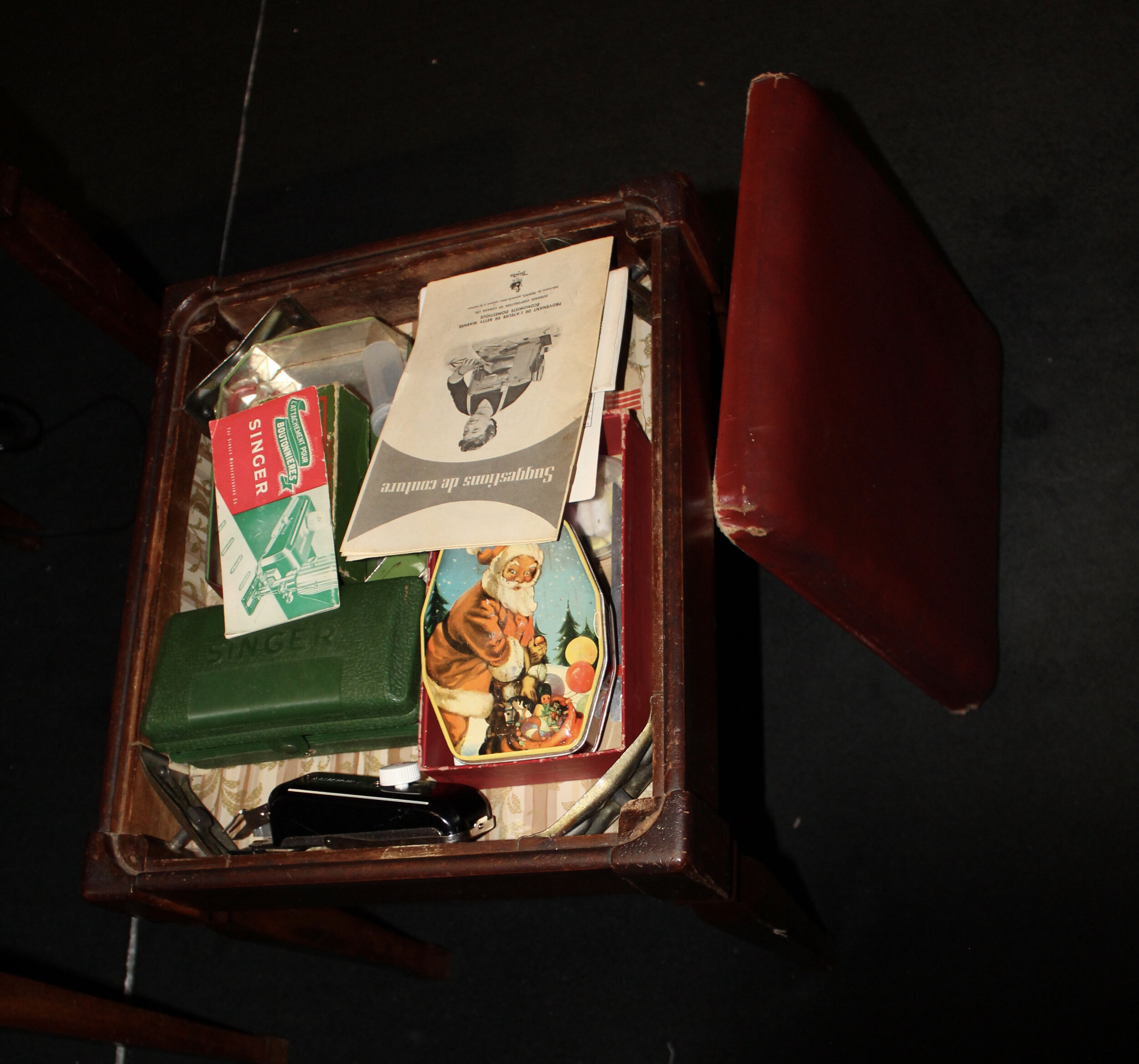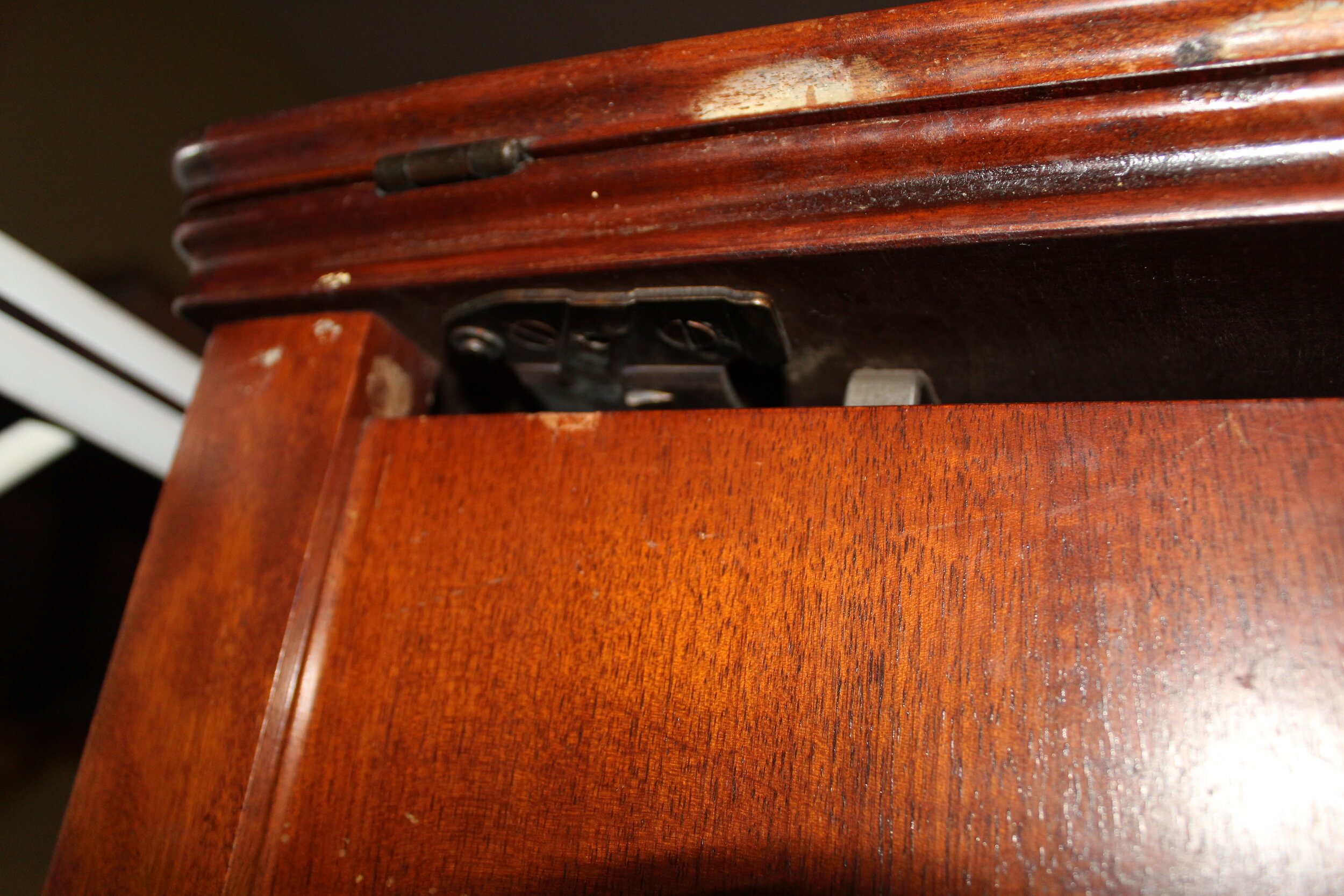As you may of noticed in my other posts, my 15-91 came with a table that it sits in (and a matching chair). I wanted to know more about this table so I first began with the ismacs.net site.
Above: Singer Cabinet (plus chair) when open
Left: Singer Cabinet (plus chair) when closed. Machine is actually tucked in under the table when in the closed position
First thing I learned is that these tables are actually called cabinets. And that there are only 6 cabinets for the 15-91 listed. My cabinet is clearly the #40 cabinet. There are two versions of this cabinet but it looks like I have the standard #40 cabinet since I don’t have the curved legs that indicate the Queen Anne style. There is frustratingly little detail though on this cabinet on the ismacs.net site. For example, it doesn’t mention anything about the years this cabinet was produced or the cabinet drawer. The accompanying chair isn’t even shown! When I look at the page for the #40 cabinet (Queen Anne Style) in comparison, it does at least show the chair and mentions the drawer. I can also surmise from the description that other singer models were used with this cabinet in addition to the 15-91. See below for some features of the #40 cabinet I have.
Edit: Adding some extra resources I found on the #40 cabinet
Above: Cabinet drawer that pulls out. When I asked about the metal piece in the cabinet (on the far right side of the drawer) in https://www.quiltingboard.com/ forums, they mentioned that they thought it was to hold an oil can (to oil the machine).
Left: Chair/stool that came with the cabinet actually has space underneath the cushion to store items.
You will notice on the right side of the photo that there is a pedal. This is actually a knee pedal and when i push against it with my knee (when I’m sitting at the machine) it will run the sewing machine. Similar to a foot pedal. The harder I push with my knee, the faster the machine goes. It took a little while to get used to using it but I actually like it quite a bit.
I was somewhat resigned that I wouldn’t learn anymore about the table however I noticed right away when I got the machine + cabinet that there seemed to be a problem with the table. If you look at my photo below, you notice on the left leaf of the table, there is an obvious slant towards the ground. I was concerned about this because 1) I was worried the leaf would break off if I put any weight on it, and 2) It somewhat hampered my quilting (the weight of the quilt caused it to start sliding off towards the left).
When I took a closer look in the area under the sagging leaf, I noticed a suspiciously sized space. A perfectly sized space for a support arm? Closer examination under the table, revealed a screwed plate that didn’t seem to serve any current purpose on the machine. Perhaps a left over piece from the support arm?
More research was needed. Some wandering on the internet brought me to the https://www.quiltingboard.com/ forums, who confirmed that not only did some cabinet models have a support arm, but that it automatically springs out when you left the leaf??? Well now I have to fix it. I took up the suggestion in the forum to buy a singer support arm on ebay. While I waited for it I read PAPPP’s Rambling where they try to fix their #42 cabinet support arm, hoping I might understand the mechanics of this arm a bit better.
Now this was my first mistake. And to spare you from making the same mistake I did, I will tell you why. What I SHOULD have done first, before ordering any parts, was remove the current screw plate and examine the part to see if it aligned with the sold part. Because as it turns out, there are different types of singer sewing machine cabinet support arms. Something I found out the day my part arrived when taking off the screw plate to replace it.
On the left is the older screw plate. On the right is the screw plate with the support arm I ordered. As you can see, the top two holes seem to align however the bottom hole clearly does not. Also the hole for the pin (top far left) doesn’t align quite right.
Now if you are like me and order the wrong part, you can try to make this work. I was able to screw 2 out of 3 of the screws in, however the automatic swing out feature for the support bar when I lift the cabinet leaf wasn’t working. And I couldn’t push the support arm under the table when the leaves of the table are closed. While I didn’t know the exact mechanics of the support arm, I suspected this had to do with the ‘pin’ under the table and the fact it didn’t align with the hole on this new screw plate.
I suppose I could have left the cabinet alone at this point. The leaf was now supported and I had a level surface to sew on. BUT NO! I was determined to get this cabinet properly fixed so I went back to ebay (I blame my engineering background). Now luckily for me, there was a part number on the original screw plate that came with the table (Simanco 136259). When I looked up this part number on ebay I was able to find a support arm. When I scrutinized the photo it did look like it aligned more closely with my original screw plate (compared to the part I previously ordered). I went ahead and ordered it (and ignored my significant other’s grumbling on how unnecessary this all was).
Eventually the part arrived and it… sat on my sewing table for 4 months. My excuse is that life kept me busy, but I was also not excited about climbing under the cabinet to try to screw in screws, without stripping them, in a tight space (my first time doing this when installing the wrong support arm was terrible). I FINALLY built up the courage today to install it.
It was surprisingly… straightforward? All the holes aligned and I was able to screw in all 3 screws. The pin fit perfectly into the remaining hole in the screw plate and I screwed in the spring (see below for how the spring is installed - I installed the spring before for the first support part I ordered, but I thought it might be helpful to include a reference photo this 2nd time).
And now for the moment of truth. Does the support arm work? See for yourself:
(I apologize in advance for the video quality. I’m using my phone and I’m often taking videos without any assistance)
Success! Finally my saga with the cabinet support arm can come to a close. Thanks everyone who helped me out! And if you happen to need a singer support arm that doesn’t go with a #40 cabinet and live in Canada… let me know! Otherwise this extra support arm I now have is just going to languish in my sewing room.











